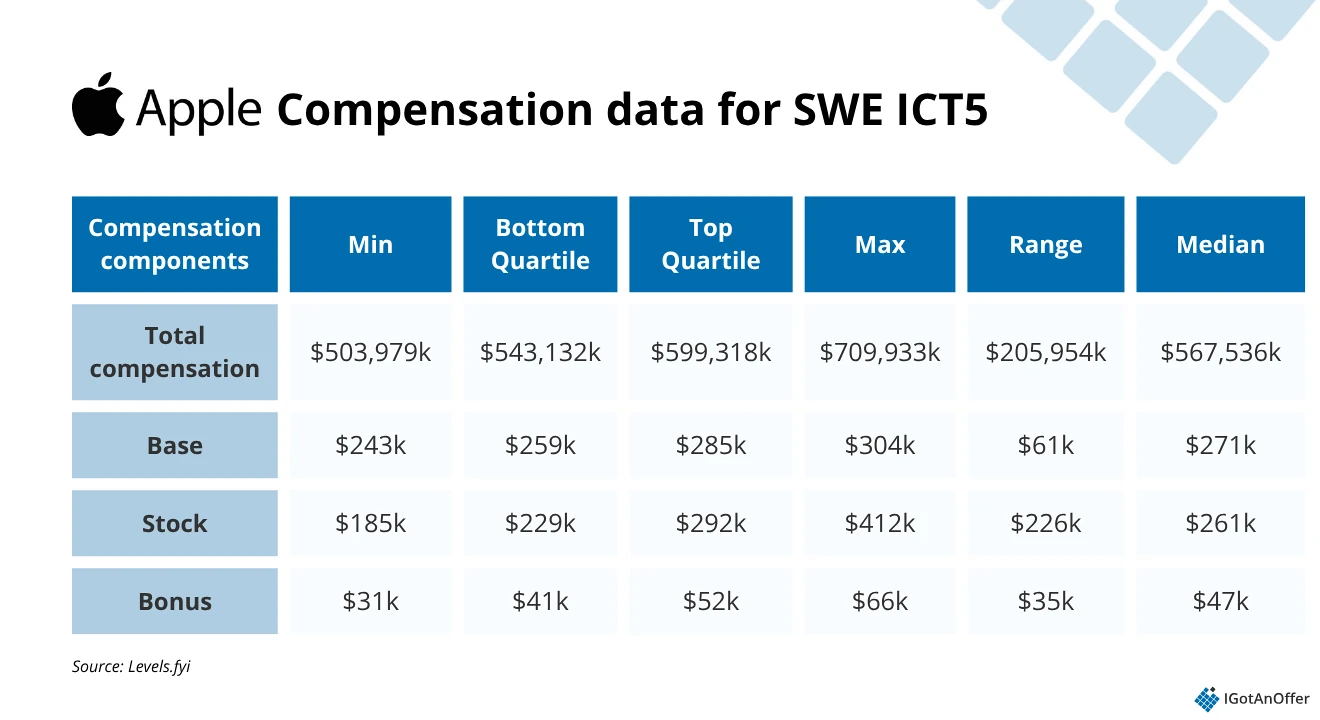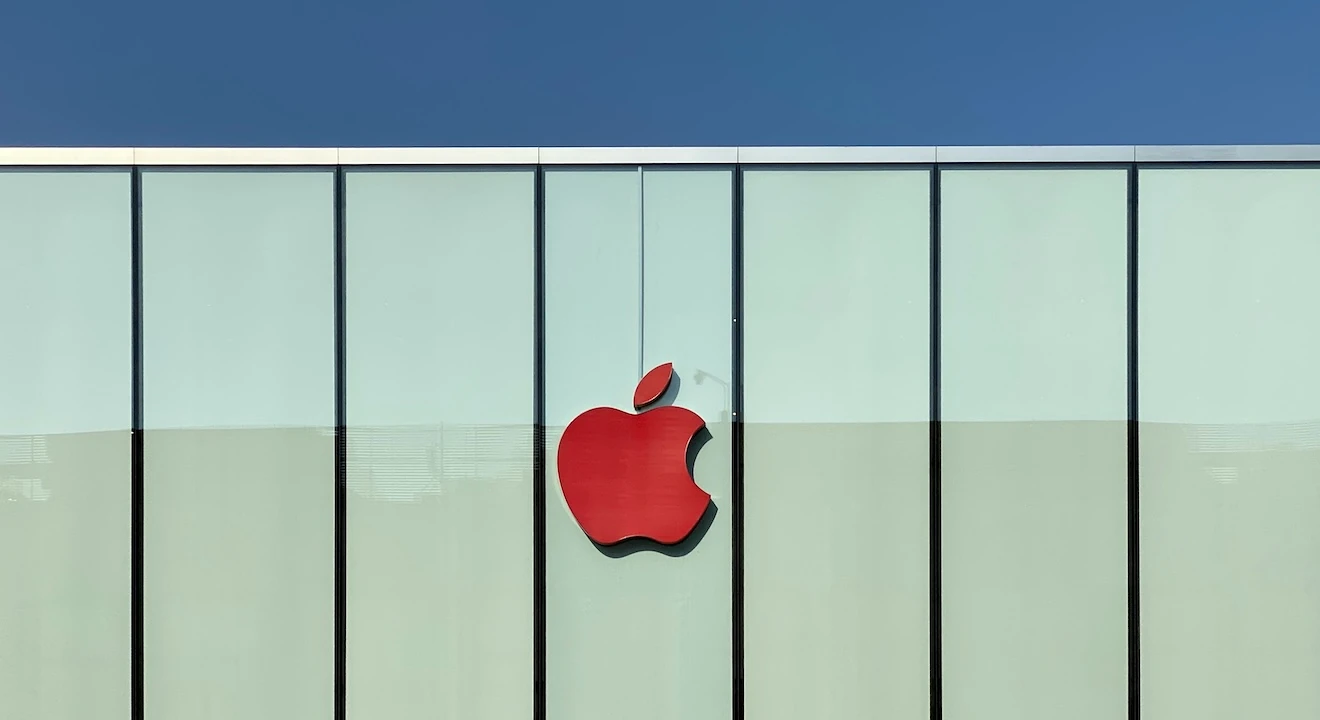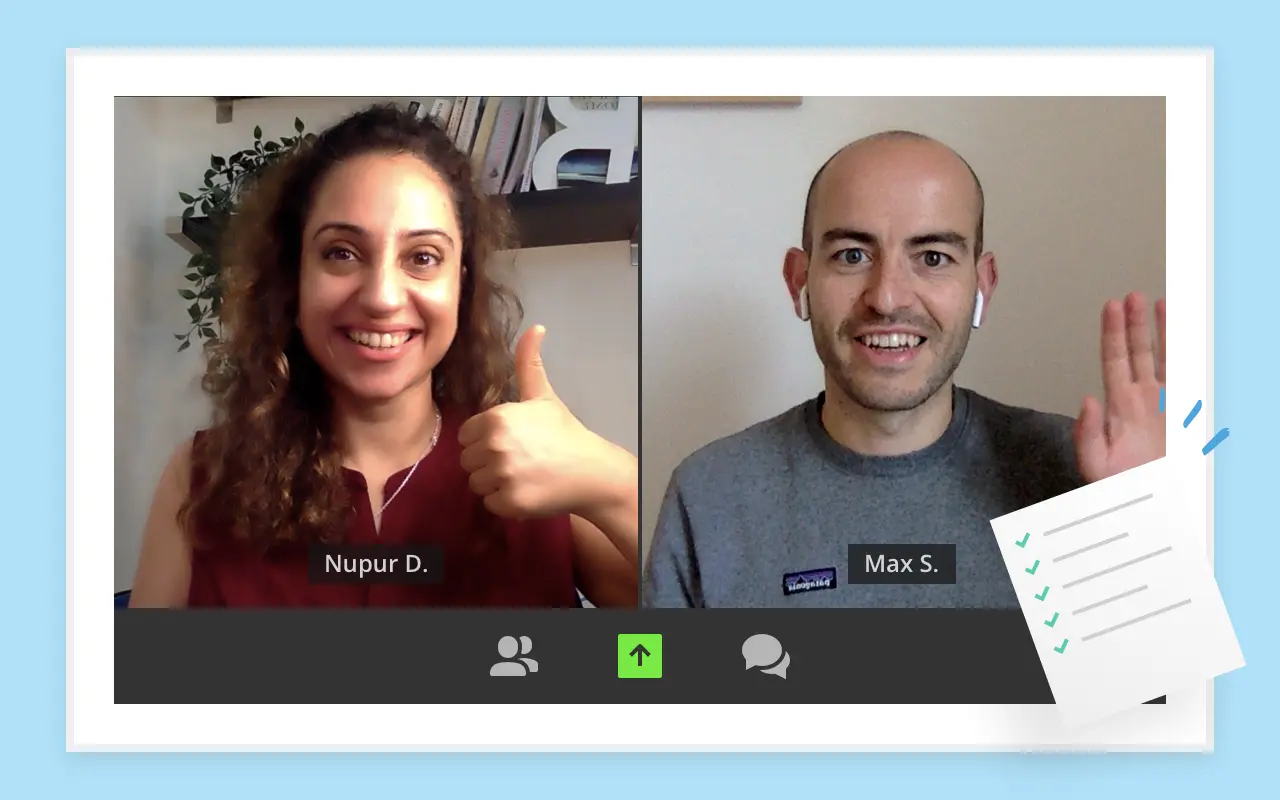You've just received your offer from Apple. The base salary looks solid. The RSU package is impressive. The sign-on bonus will help with relocation.
But is it truly competitive? More importantly, is it the best Apple can offer you?
The truth is, most candidates accept their first offer without negotiation. Yet according to a Fidelity study, 9 out of 10 job seekers who negotiate their salary have success. And with FAANG companies like Apple, the difference between accepting and negotiating can amount to $50,000 or more on the initial offer alone. That’s a lot to leave on the table.
We've put together this step-by-step guide to help you negotiate a better offer on your own.
This article is based on primary insights from our salary negotiation team, which includes former Apple recruiters and hiring managers. It's also based on written reports from candidates and other salary negotiation coaches who routinely negotiate job offers with Apple.
Here are the steps you should take when negotiating your job offer at Apple:
- Understand Apple's compensation structure
- Find weaknesses in the initial offer
- Send a counteroffer email
- Hold your ground
- Consult an expert
Book 1-on-1 salary negotiation coaching with an ex-Apple coach.
1. Understand Apple's compensation structure ↑
Before you can negotiate effectively, you need to understand how Apple structures compensation, how it varies by level, and why offers differ so significantly between candidates.
1.1 Apple's ICT level system
Apple is organized by functional expertise. So, hardware experts lead hardware, software experts lead software, and design experts lead design, and so on. This structure means compensation is tied directly to your level of technical expertise and the scope of problems you're expected to solve.
The levels typically range from ICT 1 (entry-level) through ICT 6 (senior/principal engineer). Each level represents a jump in responsibility, autonomy, and compensation. An ICT 3 might focus on individual contributions within a defined scope, while an ICT 5 leads initiatives across teams and influences strategic direction.
For this article, we're using ICT 5 Software Engineer as our primary example. That’s for a few reasons.
First, ICT 5 represents mid-to-senior level engineers. You’re experienced enough to have significant negotiating leverage but not so rare that the data becomes anecdotal. Also, it's a common target for engineers transitioning from other major tech companies. Lastly, the salary data for this level is well-documented, providing us with concrete numbers to work with throughout our negotiation framework.
1.2 How compensation scales by level and department
According to Levels.fyi data on Apple salaries, an ICT 5 Software Engineer in the US might receive approximately $286,000 base salary, $245,000 in Restricted Stock Units (RSUs) vested equally over four years, and a $41,000 sign-on bonus. This is different from an ICT 4 at the same company, especially in terms of stock and bonuses.
An ICT 4 Software Engineer receives a base salary of approximately $236,000, $142,000 in RSUs, and a $24,000 sign-on bonus. That’s a nearly half-drop in RSUs and bonuses. That substantial increase in total compensation reflects the higher bar for technical depth and impact at the senior level.
Then, for an ICT 4 Product Manager (same company, same level, different department), you’d be looking at $221,000 base, $105,000+ in RSUs, and $19,000+ in sign-on bonus, which is even lower.
The point is, the different components of your Apple offer are not all equally negotiable. This table reflects that:

While the level determines the band, individual circumstances (example: competing offers, background, interview performance) determine where you land within that band.
Two ICT 5 engineers might receive different offers based on these factors.
1.3 Can you negotiate your Apple salary?
Yes, Apple salaries are negotiable. Your Apple recruiter expects you to negotiate, and their initial offer won't be the maximum offer they can give you to join the company.
Your Apple compensation package consists of four primary components:
1.3.1 Apple base salary (moderately negotiable)
How negotiable is Apple's base salary?
It's common for recruiters to put you at the bottom or middle of the base salary band in their initial offer. But base salary bands are moderately wide at mid-to-senior levels, giving you room to negotiate.
For ICT 5 Software Engineers, the typical base salary range in the US is $280k-$310k, with most initial offers at the lower end.
How does Apple's base salary work?
This is your guaranteed income. At Apple, base salary is one of the more flexible components of your offer during negotiation.
Apple’s base salary follows the typical FAANG model. Each role, level, and location has a base salary band. The band is narrower at junior levels than at more senior levels, where there's therefore more room for negotiation.
Your base salary is paid biweekly in the US and monthly in most other countries.
1.3.2 Apple RSUs (not very negotiable)
How negotiable are Apple's RSUs?
Apple is rather restrictive with RSUs. Most candidates hear "RSUs cannot be increased" or "RSUs are what's approved by the hiring manager and panel based on the budget."
For ICT 5 Software Engineers, RSU grants typically range from $220k-$280k, but the variance is small compared to base salary. The tight RSU bands reflect Apple's structured compensation approach and limited flexibility at the approval level.
However, there's an important caveat. If Apple won't increase RSUs, they'll compensate by increasing base salary or sign-on bonus instead. This is actually good news. You can still negotiate your total compensation even if RSUs are off the table.
How do Apple's RSUs work?
Apple grants RSUs as shares of Apple stock, but you don't own them right away. You "earn" them over time as you stay with the company. This is often called a "golden handcuff."
Your offer letter specifies how many RSUs Apple is granting you and when they'll vest. For example, an ICT 5 engineer might get $245k worth of RSUs based on Apple's stock price at the time of the grant.
Apple RSUs vest 25% annually over 4 years, with a 1-year cliff. This means no RSUs vest until you complete your first year, then 25% vests. If you leave Apple before a scheduled vesting date, any RSUs that haven't vested are immediately forfeited.
You don't receive actual dividends since you don't own the stock yet. But Apple credits you with a "Dividend Equivalent Right", an extra cash amount equal to what you would've earned if you already owned the shares. This amount is paid out when your RSUs vest.
When your RSUs vest, they're treated as ordinary income. Apple automatically withholds taxes (usually by keeping some of the shares), and you'll receive the rest as actual Apple stock, which you can sell or hold.
Valuing your RSUs
There's more uncertainty around RSUs than there is around other compensation components. Here are the two biggest factors to consider:
- Stock price fluctuations: Apple's stock could go up or down, and the value of your RSUs will change accordingly. This has a huge impact on your actual financial outcome but unfortunately isn't something you control or can predict with certainty.
- Likelihood of vesting: You might decide to leave because of a difficult manager or team situation, or you might be affected by a reorganization. If this happens within 4 years, you won't take full advantage of your grant.
It's important that you take these aspects into account when assessing and negotiating your offer. Unless you're 100% comfortable with these risks, we recommend negotiating for a higher base salary and sign-on bonus, which are more certain financial benefits.
1.3.3 Apple sign-on bonus (negotiable)
How negotiable is Apple's sign-on bonus?
Apple is actually quite flexible with sign-on bonuses once you start negotiating. For ICT 5 Software Engineers, sign-on bonuses typically range from $30k-$60k, with most initial offers at $40k-$50k.
How does Apple's sign-on bonus work?
The sign-on bonus is a one-time payment made during your first few months. Unlike RSUs, this is guaranteed cash regardless of stock performance.
There are two main ways to think about your sign-on:
- Most people think about it as a lump sum that helps cover any performance bonus or unvested equity you're walking away from at your current company.
- But if you're not walking away from anything, you can also look at it as a bridge between your start date and your first RSU vesting date (which occurs at the 1-year mark at Apple).
Apple will pay your sign-on bonus as a lump sum in the first few months of your employment. There's typically no clawback if you leave after vesting, though this can vary. Confirm with your recruiter.
1.3.4 Apple performance bonus (standardized, but may be negotiable)
How negotiable is Apple's performance bonus?
Performance bonuses are set at the company level for each role and level. Any improvement you get to your base salary will be compounded by your performance bonus, so it's a factor you should take into consideration when negotiating your base.
How does Apple's performance bonus work?
Apple offers performance-based bonuses with target percentages ranging from 5% to 25%, depending on your role and level. For most engineering and technical roles, bonuses typically fall in the 10-20% range.
Performance bonuses are paid annually and are based on both your individual performance and company performance. The actual payout can vary, but most employees at Apple achieve their target bonus or higher.
1.3.5 Apple's benefits and perks (not negotiable)
Apple is competitive on benefits and perks. Here's what's typically included:
- Health and wellness: Apple offers comprehensive medical plans with in-person and virtual care options. Larger campuses have onsite wellness centers, and the company provides fitness reimbursements. Mental health support includes confidential counseling services.
- Family support: New parents receive paid parental leave with a gradual return-to-work option. Apple also provides paid caregiving leave, fertility treatment coverage, and resources for childcare and eldercare.
- Financial benefits: Beyond RSUs, Apple offers a 401(k) with matching contributions, discounted stock purchase plans, and income protection benefits. The 401(k) match is competitive and helps build long-term financial security.
- Learning and development: Apple University provides internal courses on leadership, communication, and design philosophy. The company also offers tuition reimbursement for external degrees and certifications.
- Other perks: Apple matches charitable donations, provides volunteer incentives, and offers employee discounts on products and services.
- Time off: Apple's paid time off can be “pittance”. They provide 12 days of vacation per year to newly hired employees, plus 12 days of sick leave. This increases to 15-25 days with tenure. By comparison, Netflix offers unlimited PTO, while Meta provides approximately 21 days, and Google offers 15-25 days, depending on tenure.
But you get several built-in breaks, including the entire Thanksgiving week and the stretch from Christmas Eve through New Year’s. So maybe you can work with that if it fits.
You also receive up to four weeks of remote work each year, which can be taken at your convenience.
Keep these benefits in mind when comparing total compensation across offers. They can tip the scales even if the cash components are similar.
1.4 How much additional compensation can you negotiate at Apple?
Negotiation outcomes vary significantly by level. Based on our experience, here's what you can expect at these ICT levels:
- ICT 2-3 (junior): Typically $5k-$25k increases
- ICT 4-5 (mid-senior): Typically $25k-$75k increases
- ICT 6+ (senior/principal): $75k-$150k+ increases possible
Your actual results depend on competing offers, specialized skills, and initial offer positioning within the band.
2. Find weaknesses in the initial offer ↑
Almost every first offer from Apple has wiggle room. As Alex, a salary negotiation coach at IGotAnOffer, explains: "The first offer is never the best offer. Most companies expect you to negotiate and even leave room in the budget, anticipating that."
So, where are the gaps in Apple's offer you can work around?
2.1 Where Apple is usually flexible: Base salary and sign-on bonus
Recruiters often start with a conservative number. So, you can walk away with a bump up in salary when you go prepared (knowing how to negotiate your offer) or go with competing offers in hand.
Apple might not open the door wide. But it does open when you knock with evidence and know how to negotiate.
You can also negotiate your sign-on bonus. As salary coach Malay explains:
“Sign-on bonuses are highly negotiable and can sometimes be increased based on competing offers or if you bring specific expertise.”
She was talking about Amazon, but the principle applies to FAANG companies, including Apple.
When RSUs are capped or VP approval slows down equity adjustments, recruiters sometimes use a higher sign-on bonus as a workaround.
The performance bonus structure is more standardized. It’s typically a fixed percentage tied to role and level. But even here, strong candidates have managed to secure favorable terms. If you can show your impact or reference competing offers with more aggressive bonus structures, Apple occasionally makes minor adjustments or adds one-time incentives to close the deal.
2.2 Where Apple typically won't budge: RSUs
Apple is stingy with RSUs. That’s the way one candidate put it. And it’s true: RSUs are difficult to negotiate at Apple.
Most of the responses you’ll get around RSU increases are "RSU cannot be increased," or "RSUs are what's approved by the hiring manager and panel based on the budget."
Of course, there's a caveat. If Apple won't increase RSUs, they'll compensate by increasing base salary or sign-on bonus instead.
2.3 How to identify weaknesses in your specific offer
To find weaknesses, compare your offer against three benchmarks:
Benchmark 1: Market data
For the main compensation components (RSUs, sign-on bonus, and base salary), identify the ranges for your role, level, and location.
You should use multiple sources when establishing these ranges. We recommend:
- Levels.fyi: Particularly strong for tech role salary data by level and location
- Glassdoor: Great for general salary ranges and company reviews
- Blind: Can provide additional data points on Apple offer ranges and recent negotiation outcomes, though use this to validate rather than replace professional salary data sources
- Comparably: Provides salary data by role and company
As you do your research, remember that there’s a time lag between the moment offers are reported on these websites and the time at which they were actually made. This means the ranges you will find may be lower or higher than what’s currently being used by Apple.
Once you have a sense of how much you can ask for for each compensation component. It’s essential to remain realistic as you complete this exercise. Here are two sanity checks we recommend making before settling on specific numbers to request.
Check 1: It’s unlikely that you’ll manage to get to the very top end of the range for all components. Broadly speaking, there are two extremes.
If your goal is to maximize total compensation and you’re comfortable with the associated risks, then you could focus on maximizing your RSUs.
If you’re interested in more certainty, then you could focus more on base salary and the sign-on bonus, but you’re less likely to reach the top end of total compensation.
Check 2: You should be realistic about the skill set you bring to Apple.
If you have specialized expertise (machine learning, hardware systems, etc.) or come from a top competitor, you have strong negotiating power.
Benchmark 2: Your competing offers
If you have competing offers from Google, Meta, or other major tech companies, this is your good leverage.
Apple, like most large tech companies, operates within tightly controlled compensation bands, and those bands rarely move without external pressure.
A competing offer changes that dynamic. It gives you normative leverage: meaning, a concrete, market-based reason for Apple to reconsider your package.
Recruiters can’t arbitrarily raise your base or equity. They need a justification that they can take up the approval chain. When you can point to a Meta or Google offer with a higher total compensation, you’re showing proof that the market values you at that level.
It also creates negative leverage. If Apple doesn’t adjust, they risk losing you to another FAANG. Recruiters know this, and since hiring approvals and timelines are costly, they’ll often push internally to match or come close.
We'll cover exactly how to present these offers in Step 3.
Benchmark 3: Your background and value
Did you come from a prestigious company (say Meta, Uber, Netflix, etc)? Do you have specific expertise in an area Apple prioritizes? Did you excel in your interviews?
These become reasons why Apple should pay at the higher end of the range. If you're interviewing for a Product Manager role, your technical depth and demonstrated ability to influence stakeholders matters.
3. Send a counteroffer email ↑
Now that you know what’s reasonable to ask for and what gives you leverage, let’s move to the next stage: how to communicate it effectively.
3.1 Consider setting a "walk-away" number
Before starting negotiations, write down your "walk-away" number, the minimum compensation you'd accept to join Apple. If you negotiate an offer above this number, you'll accept it. If not, you'll either stay at your current company or continue interviewing elsewhere.
This number should be based on your research, other options, and personal circumstances. Having this figure in mind will help you keep a clear head during negotiations and know when to accept or move on.
Now, to your counteroffer. There are two common approaches to making a counteroffer:
Approach 1: Share your walk-away number
State the minimum compensation you'd accept and make clear that below this number, you'd prefer to stay at your current company or pursue other opportunities. The benefit is simplicity and clarity. The downside is you might leave money on the table if your walk-away is lower than Apple's maximum offer.
Approach 2: Start higher and leave room for negotiation
Begin with a higher number than your walk-away point, leaving room for back-and-forth negotiation. This approach has more upside potential but involves more negotiation cycles and discomfort. It's the approach that tends to yield the highest total compensation.
3.2 How to structure your counteroffer email
Keep it professional, concise, and focused on business value.
Don't make it emotional or about fairness. According to Victoria Medvec, professor at the Kellogg School of Management and author of Negotiate Without Fear:
"Don't create a rationale based on what's right or what's fair. Instead, reference information about what others earn to anchor your request, but keep the conversation focused on the employer's interests."
This approach works well at Apple, as compensation decisions go through structured approval processes that require documented justification. You need to provide objective justification so the recruiter can effectively advocate for your higher compensation internally. Additionally, data-driven arguments are more effective than appeals to fairness.
Here's a template structure that’s not centered on emotion:
Opening: Express genuine enthusiasm about the role and Apple.
- "Thank you for the offer to join Apple's [Team/Division]. I'm genuinely excited about the opportunity to contribute to [specific initiative or team], and I believe my background in [specific expertise] aligns well with Apple's priorities in this space."
Present market data: Use "normative leverage" or objective criteria that both sides can agree on.
- "Based on my research using Levels.fyi and discussions with others in similar roles, an ICT 5 Software Engineer with my background in [area] typically commands a total compensation range of [X-Y] in [location]. My current offer sits below this range, particularly in base salary and sign-on bonus."
Highlight your unique value: This is positive leverage. Make the recruiter's job easier by articulating why you're worth more than the standard offer.
- "In my interviews, I demonstrated [specific technical capability or achievement], and my previous experience at [Company] shows I can [specific value]. These are areas where I can make an immediate impact."
State your ask clearly: Don't be vague. Be specific about what you want.
- "I'd like to request: base salary of [X], sign-on bonus of [Y], and RSU grant of [Z]. Alternatively, if the RSU grant is fixed, I'd appreciate an increase in base salary to [amount] to reflect market rates for this level."
Mention competing offers if you have them: This is a form of negative leverage. Be strategic about how you present it.
- "I'm fortunate to be considering other opportunities as well, but Apple remains my top choice given [specific reasons]. I believe this adjustment reflects both market rates and my fit for the role."
Close professionally.
- "I'm very interested in joining Apple and hope we can find alignment on these numbers. I'm happy to discuss further. Thank you for considering my request."
Some more templates for you:
Non-negotiable counteroffer email template
Hi [Recruiter Name],
Thanks again for taking the time to interview me and for making me an offer to join Apple. I'm genuinely excited about the opportunity to contribute to the [team/project] and confident I can make a positive impact from day one.
I've researched typical compensation for my level, and I'd like to propose an adjustment. I also reflected on what I'd be walking away from, including [mention any current bonuses, unvested equity, or benefits].
After careful consideration, the minimum compensation I'd be willing to accept to join Apple is:
- Base Salary: $[X]k
- Sign-On Bonus: $[X]k
- RSUs: [Accept the offered amount]
I realize these are higher numbers than your initial offer. However, below this compensation level, I prefer to remain at my current company and explore other opportunities.
As I mentioned in my interviews, I'm genuinely excited to join Apple because [specific reason about team, product, or company mission]. I'm hoping your compensation team can move closer to these numbers.
I'm happy to jump on a call to discuss if that would be helpful.
Best regards,
[Your Name]
Flexible counteroffer email template
Hi [Recruiter Name],
Thanks again for interviewing me and for extending an offer to join Apple. I'm really excited about the opportunity and confident I can make a meaningful contribution to the team.
I took time to review compensation ranges for my role, level, and location, and I'd like to request that the offer be moved closer to the following numbers:
- Base Salary: $[X]k
- Sign-On Bonus: $[X]k
- RSUs: [Accept the offered amount]
In addition, I wanted to highlight what moving to Apple would mean for me personally:
- I'd be walking away from $[X]k in current performance bonus and $[X]k in unvested equity
- My current company also provides [mention specific benefits] that I'd lose.
As I mentioned during my interviews, I'm particularly excited about [specific team/project/mission], and I'm really hoping your compensation team can work with me on these numbers.
If it's helpful, I'm happy to jump on a call to discuss these points further.
Best regards,
[Your Name]
Whichever template you decide to use, keep these key points in mind:
- Reiterate your genuine excitement about joining Apple.
- Thank them for the opportunity and their time.
- Lay out what you believe is fair compensation based on research.
- Mention what you're walking away from (this justifies your ask).
- Clearly ask them to take your request to their compensation team.
- Offer to discuss over a call if needed.
- Keep the tone respectful and professional.
3.3 Timing considerations
While some recruiters may create urgency, Apple's approval process typically takes 3-7 business days regardless. Don't feel pressured to respond immediately.
Wait at least 24 to 48 hours before responding to the initial offer. This signals that you're seriously considering other options and aren't desperate.
When a recruiter pushes for an immediate phone call, ask for time to consider:
"I appreciate the urgency. I'm very interested in this opportunity, but I'd like a day to review the offer carefully before we discuss."
3.4 Know what to expect next
Once you send your counteroffer email, Apple typically reviews your request internally. Because adjustments require approval from a VP or SVP, expect a response within 3-7 business days.
Based on candidate reports, initial offers typically arrive 3-5 business days after your final interview. If you counter, expect the negotiation process to take 1-2 weeks, as adjustments often require approval from a VP or SVP.
Expect some back-and-forth, too. This is normal.
4. Hold your ground ↑
The most common mistake in negotiation is caving when Apple pushes back. Recruiters often use the phrase 'that's not possible' as an opening negotiation posture, not a final answer. Understanding their tactics helps you maintain a competitive edge.
4.1 Understanding negotiation tactics
The "VP approval" response:
When a recruiter says they need VP approval for your request, they're being truthful, but this is also their opening negotiation posture. It doesn't mean no. It means, "Let me see if this is justified."
This is where your email outlining your market research and unique value becomes critical. As David Buckmaster, author of Fair Pay, advises:
"Help the recruiter tell your story internally. Make their job easier with solid arguments oriented around the business. Otherwise, they're going to have a hard time getting it approved."
The "We can't move on RSUs" response:
Take this at face value. RSUs are determined by the level and role, and Apple rarely changes them. However, if they can't move on RSUs, negotiate on base salary and sign-on bonus as compensation.
The "This is the maximum we can offer" response:
This may or may not be true. If you have a firm competing offer, this is the moment to mention it explicitly.
You don't need to provide details, but saying "I have another offer at [company] that's competitive at [total amount]" creates pressure.
4.2 How to respond to pushback
If Apple comes back with a lower number than you requested, don't immediately accept. Instead, respond with:
"I appreciate the increase, but based on the market data I've referenced, I was hoping we could reach [your original ask]. What flexibility do you have, particularly in base salary and sign-on bonus?"
If they say they truly can't move further, ask if there are other factors you haven't discussed (such as timing, role clarity, or team placement) that could help us reach alignment.
4.5 When to walk away
Not every Apple offer is worth accepting, even after negotiation has taken place. If Apple's final offer is significantly below market (you can verify this on Levels.fyi and Blind), and they won't move further, you may be better off waiting for the next opportunity.
This is especially true if you have a competing offer that's meaningfully better.
5. Work with an expert negotiator (optional, but high-ROI) ↑
If you're uncomfortable negotiating alone (or want to maximize your outcome), consider working with a professional negotiator who has Apple-specific expertise.
We’d recommend IGotAnOffer. Yes, we’re biased. But that’s because our team includes 10+ former Apple recruiters and hiring managers who have collectively negotiated thousands of Apple offers across all ICT levels and organizations. They negotiate daily and possess insider knowledge of Apple's approval hierarchies, compensation bands, and the arguments that succeed with compensation committees.
For more info on expert salary negotiation, you might want to check out these resources:
A well-executed negotiation with professional guidance typically yields $10k-$100k+ in additional compensation. Meaning even the more premium coaching packages ($150-$500) deliver 10x to 100x+ ROI.
Here's what professional coaching can help you with:
- Understanding Apple's specific approval hierarchy and constraints
- Finding and articulating weaknesses in your initial offer
- Determining what reasonable total compensation is for your role
- Practicing mock negotiations over the phone
- Handling objections and push-back from recruiters
- Optimizing timing and leverage from competing offers
Remember, Apple's first offer is not the final offer. With the right strategy, you can successfully negotiate significant increases in total compensation.
Click here to browse our team of salary negotiation coaches.
Browse salary negotiation coaches















